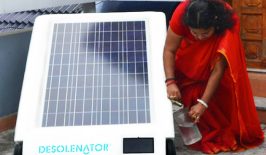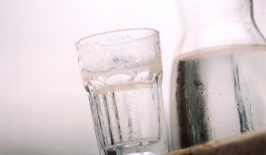Creating a cloud inside a shipping container, powered by renewable energy – the winner of the Water Abundance XPrize beat off 97 other teams to win 1.5 million USD to develop their innovative technology that “makes water out of thin air”.
XPrize is a nonprofit organization that sets up public competitions designed to encourage technological innovation for the social and ecological good. This particular category of the prize, named “Water Abundance”, tasked entrants with producing water from thin air at vastly lower costs than current commercially available technology – all the while using renewable energy. The XPrize was looking for a device that extracts at least 2,000 litres of water a day from the atmosphere, using renewable energy, at a cost of no more than two cents per litre. That’s enough water for 100 people per day.
The winning design from the Skysource/Skywater Alliance combines the already-existing air-to-water technology found in Skywater’s air-to-water dehumidifiers with an innovative kind of energy input. Skywater’s container-shaped dehumidifiers cool the air inside them using a compressor, bringing in warm air from outside to create condensation which is funnelled into storage inside the container and can be funnelled out as water. It’s essentially the same process that occurs in the atmosphere, as rising warm air hits colder air above, forming clouds. The result is water – extracted from the air we breathe – that does not deplete existing supplies.
The energy input used in the system is the truly interesting technology here. The system is called WEDEW, which stands for wood-to-energy deployed water, and it generates power to run the system via a biomass gassifier. This is a device that converts solid biomass fuel into a gaseous combustible gas via pyrolysis. It can work with a wide range of different biomass inputs, including as wood chips, coconut husks, or pine bark.
The XPrize winners even claim the process is carbon negative, as the WEDEW produces charcoal, which can be used in a variety of ways, including as a useful fertilizer for growing plants. While burning biomass does release carbon emissions, it is officially classified as a renewable energy source according to various legal frameworks, because of the fact that its organic matter that is burnt, and those plant stocks can be replaced with new growth.
Interestingly, the winner didn’t actually make the original list of top five finalists. Four of the final five teams showed promising and highly-effective solutions, but weren’t able to reach the mandatory criteria needed to win by the final judging. This allowed the SkySource/SkyWater Alliance to re-enter, and following final testing, proved it was able to meet the XPrize criteria.
The runner-up is Team JMCC Wing, a Hawaiian-based operation, using an innovative and portable wind turbine to supply commercially available industrial atmospheric water generators. The runner-up received 200,000 USD from the XPrize team to support advancing the concept further.
Intriguingly, there had been criticism of the XPrize announcements, with a well-known YouTuber pointing out that technology near enough to the same functioning level already exists. However, I’d say many of the points raised miss the point. The built-in renewable energy aspects and low-cost for production of water are hugely important. Both of the top-two solutions are portable and decentralised, meaning they could be set-up anywhere from water-scarce regions to disaster zones.
In addition, the launch of a major prize is a rising-tide-floats-all-boats situation. As the nearly 100 teams attempt to discover innovations, new ideas, spin-offs, and challenges emerge. Not all will work or be solved or even be useful, but the XPrize provides more than research in a lab, or a crowdsourced venture which might not quite make the big time.
And at the cost, it’s far cheaper than other initiatives RESET has covered before, such as from ZeroMass, which produces just a few litres per day from a solar panel installation, and Water-Gen, which relies on stable grid power.






